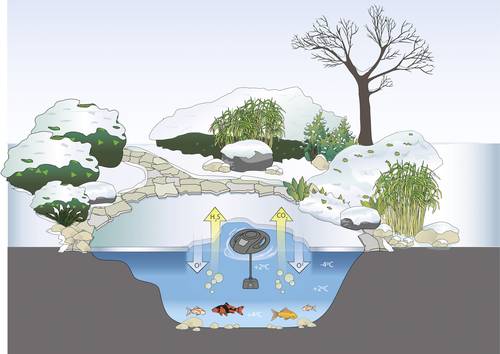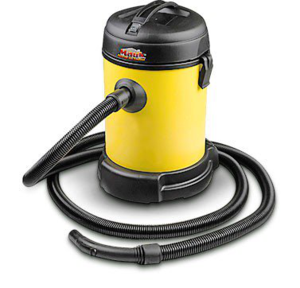Pond maintenance » Do it right and enjoy your garden pond
Published: 12.08.2021 | Reading time: 7 minutes
This text is machine translated.
Modern companies increasingly have small oases of relaxation. Employees and business partners should not only feel comfortable indoors - the design of the outdoor environment also plays a major role.
Technology makes it possible to equip even small areas with a pond. The water can become home to low-maintenance fish or the system can be designed as a pure plant pond.
Once integrated into the overall picture, garden ponds require regular maintenance: With the appropriate background knowledge and suitable equipment, the effort involved is comparatively low. Our guide presents the most important aspects of proper pond maintenance.
Anyone who is concerned with the topic of ponds wants to know how much time needs to be planned in order to maintain the entire facility. After all, employees, business partners and customers should be able to enjoy the view and not look into murky water.
The idea that the larger the pond, the more time-consuming it is to maintain it is wrong. In fact, the opposite is true: as the volume of water increases, it becomes easier to keep the pond biotope stable. Good water quality is maintained even if the fish population increases and animal excrement and general contamination increase.
A small pond reacts more sensitively to changes in nutrients and pH value, heats up more quickly in summer and is more likely to struggle with algae. If in doubt, you should therefore always opt for a larger pond if possible.
Gentle means of water treatment should be used to suit the amount of water. For example, the growth of floating and filamentous algae can be curbed, which makes pond maintenance easier overall. Many products also work with the indication pH-Minus, as they can lower the overall pH value of the pond water.
It is important to use pond care products that purify the water without destroying the biological balance. Every aquarium and pond owner knows that the water must never become “hygienically pure”, as only sufficient bacteria in the biotope can prevent the
Pond filter
The main focus is on the pond filter. As the heart of the pond system, the filter ensures biological balance. The mechanical filtration components work 24/7 to filter coarse impurities such as leaves and other organic material from the pond water. In order for this filter function to be fulfilled, the pond filter must be cleaned regularly.
In principle, the pond technology can be cleaned with clear water, but pond maintenance is quicker and more effective with cleaners that have been specially developed for pumps and the like. This gently removes deposits such as limescale and extends the service life of the technology.
Skimmer
A skimmer in the garden pond is also useful for clear water. Especially in spring, the pollen count causes a lot of deposits on the water surface. A skimmer removes this, which not only looks better to the human eye, but also improves the oxygen exchange for fish and plants.
As temperatures rise, oxygen consumption in the garden pond also increases. Depending on the number of plants and fish, this may involve some work. For example, it may make sense to install an air pump set to add more oxygen to the pond water.
In summer, there is also increased algae growth. A large accumulation of algae and dead plant parts should be removed regularly using an algae net.
A landing net also remains an important companion in the fall. Leaves can be removed from the water in a few simple steps. However, it is worth using a vacuum cleaner for large ponds.
Practical tip: Never forget the pond bank
If there are shrubs and trees in the garden around the pond, branches should be trimmed in the fall. Pond shears should be used to ensure that the distance to the water's edge is around 120 centimetres.
Cloudy water or algae bloom?
In the event of problems with cloudiness or increased algae growth, tried and tested pond additives help to restore the balance in the pond biology.
When the cold season begins, this means the start of a dormant period for plants and fish. Important for fish stocking: Not every species can overwinter in the garden pond. If in doubt, they should therefore be brought indoors from the garden.
The other animals can best spend the winter in the garden pond if an ice freezer is used. This ensures that the water cannot freeze within a certain radius, even at sub-zero temperatures.
The water surface is therefore spared a layer of ice and gas exchange can continue to take place in winter. When using an ice-free holder, only the float can be seen from the water surface, while the pump continues to do its work in the deep water.
Autumn
- Fish sludge from the bottom of the pond (October).
- Fish off leaves.
- Stretch a leaf protection net over the pond.
- Take the filter and pumps out of operation.
- Clean the pumps and store them in a water bucket indoors for the winter.
- For shallow ponds (less than one meter deep), possibly install pond heaters or ice-free holders.
- Cut off aquatic plants close to the surface, the stems act as a “snorkel” for gas exchange when there is ice.
Our practical tip: Mud vacuum cleaner
Nature takes its course, plants die and remain in the pond, in the fall leaves fall into the pond and sink to the bottom. This is joined by fish droppings and leftover food. This organic waste is decomposed by bacteria. To a certain extent, this is desirable as it creates nutrients for plants. However, this process can quickly get out of hand in a garden pond (sealed with foil or plastic).
If this layer of sludge is too thick, anaerobic processes take place in the lower layer, i.e. decomposition in the absence of oxygen. This results in the formation of foul-smelling putrefactive gases such as hydrogen sulphide. The pond has “tipped over” and fish are in mortal danger!
This is particularly true in winter when the ice cover is closed: the putrefactive gases can no longer escape, there is no gas exchange. The putrefactive gases can poison the water! For this reason, there should be as little organic material in the water as possible before the start of winter. There is only one thing to do: the excess sludge must be removed! Sludge vacuums are ideal for this.
These practical devices are similar in design to a wet/dry vacuum cleaner and many can also be used as such devices. Just like a vacuum cleaner, the excess sludge is simply sucked away from the bottom of the pond. Automatic devices stop when the container is full and empty themselves to continue the process afterwards. Sludge should be vacuumed in the fall and spring.
How can fish be protected from predators?
Just as important as the fight against algae and insufficient nutrients in the garden pond is the protection of the system against predators. This includes small animals such as cats as well as birds of prey. As it is almost impossible to keep predators away from the entire garden, it is worth investing in a fish protection set.
The protection is usually attached to several earth spikes around the pond. Wire is stretched across the top ends and laid from one spike to the next, thus protecting the entire pond.





